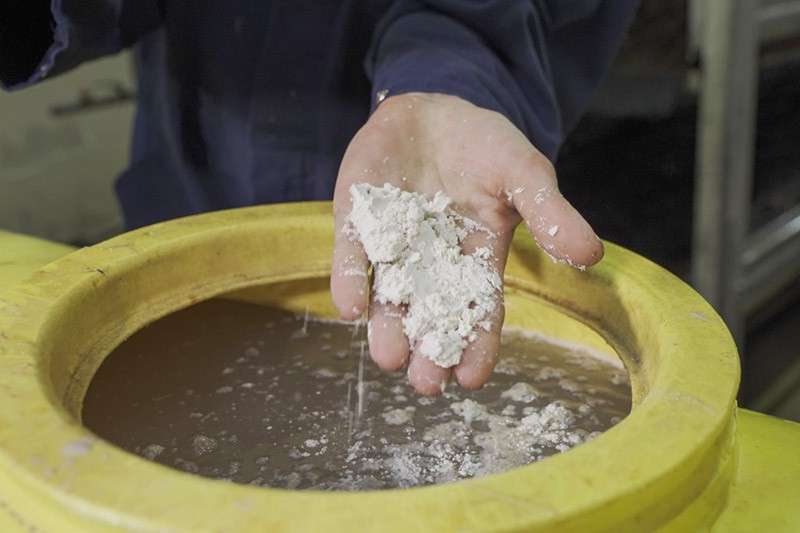Nematodes for
CONTROL MUSHROOM PESTS BIOLOGICALLY
The biggest pests in mushroom cultivation are fungus gnats and phorid flies. These two species can be controlled biologically and effectively with nematodes.
CONTROL SCIARID FLIES WITH NEMYCEL®
Fungus gnats feed on compost and prefer unsprayed compost to compost colonized by Agaricus mycelium. The adult flies are attracted to the volatile components of the compost, so it can be infested any time after pasteurization when it is cool. The adult flies are 3 - 4 mm long and can be distinguished from other fungal pests by their long antennae.
Our nematode product nemycel® contains nematodes of the species Steinernema feltiae, which is specialized in controlling Sciarid larvae. After application, the nematodes penetrate the larva through body orifices and release a symbiotic bacterium. The bacteria multiply in the larva and kill it within a few hours.

Easy application of nemycel®
Mix the nematode powder in a water barrel and pour it evenly over the compost using the sprinkler system or by hand. Alternatively, the nematodes can be poured onto or mixed into the substrate when filling the tanks. The nematodes are most effective when the water content in the substrate soil is 60-70%.

Timing is everything
The most crucial factor for a successful control of the Sciarid fly is the application timing, which is based on the life cycle of the Sciarid fly. For a successful treatment there must be larvae in the substrate at the time of application. Eggs are laid when the compost is filled and first larvae appear after 5 days. Therefore, apply as late as possible, i.e. with last watering. Splitting the full dose over two application dates a few days apart is advantageous and leads to better results.
Dosage recommendation for Phase II and Phase III composts
The general dosage recommendation is 2 million nematodes per m² applied in 1 liter of water per m². Two strategies can be used for effective application, divided into a single application and a split application.
Single application: 2 million / m² at the last irrigation or on day 12-14.
Split application: 1 million / m² immediately after application and 1 million / m² at the last watering.

ADVANTAGES OF NEMYCEL®
High effectiveness
80% of larvae in compost can be killed by the application of nemycel®. For best results, simply dissolve nemycel® in water and feed into the irrigation system

Good compatibility
The nematodes in nemycel® are infective dauer larvae. At this particular stage, they can be combined with many active ingredients, whether biological or chemical.
nemycel® can be mixed in the tank with SporGon or Vivando.
Sodium hypochlorite at a concentration of 0.05% has no effect.
Chlorine up to 50 mg per liter of water has no effect.
Hydrogen peroxide should be applied 3 days before or after Nemycel application.


No microplastics
Because of our philosophy, we do not use any type of microplastic. Instead, our formulation is based on natural diatomaceous earth, which has the advantage of dissolving easily in water and not clogging the irrigation system.

PRODUCTVIDEO NEMYCEL®
CONTROL PHORID FLIES WITH NEMATODES
Phorid larvae (Megaselia halterata) feed on the mycelium, so the adult flies are not attracted to the compost until after they have been pecked to lay eggs. The larvae are white, 1 to 6 mm long, stubby at one end and pointed at the other. They feed on the growing fungal mycelium, but rarely on the fruiting bodies themselves. They can be distinguished from sciarid larvae by the absence of the black head and develop more rapidly into a pupa. Adult phorids act as a vector for dry bubble (Verticillium fungicola). 75 flies per sqm (7 per sq ft) may already cause an outbreak of this disease.
Phorid larvae can be effectively controlled with the nematode product nemycel® phorid fly.
 Adult phorid fly (Megaselia halterata)
Adult phorid fly (Megaselia halterata)
Application conditions
At the time of application, phorid larvae or adults should be present in the compost so that the nematodes can multiply in the insects. The nematodes are effective at compost temperatures up to 30°C (86°F). At higher temperatures, nematode effectiveness decreases. Nematodes work best in substrates with a water content of 70%.
Application
nemycel® Phorid fly dissolves in water to form a suspension that can be easily applied to plants. All screens must be removed. Use nozzles with a diameter of at least 0.8 mm. The pressure should not exceed 5 bar (80 psi).
 Phorid fly larvae in the compost
Phorid fly larvae in the compost
Dosage
The Phorid fly has a short larvae stage which is hard to target. The larvae are only susceptible 4-5 days (at 25°C / 77°F) for nematode infestation. Therefore multiple applications with one bigger hit at casing and then less dosages later
is the best way to control phorid fly larvae significantly.
At casing - apply on compost |
Day 3-4 after casing |
Day 9-10 after casing |
Day 15-18 after casing befor 1st flush |
After first flush |
|---|---|---|---|---|
| 1.6 mio/ m² | 0.8 mio/ m² | 0.8 mio/ m² | 0.8 mio/ m² | 0.8 mio/ m² |
 Entomopathogenic nematodes
Entomopathogenic nematodes
Effect
The nematodes actively search for the larvae and penetrate inside them. The larvae stop feeding fast after infestation and die after 2-3 days. The nematodes multiply inside the dead larvae and get out to prey on more larvae after 7-10 days.
Compatibility
nemycel® phorid fly can be mixed in the tank with SporGon or Vivando.
Sodium hypochlorite at a concentration of 0.05% has no effect.
Chlorine up to 50 mg per liter of water has no effect.
Hydrogen peroxide should be applied 3 days before or after Nemycel application.
 Dead phorid larvae with nematodes inside
Dead phorid larvae with nematodes inside
Research
This research on the Phorid Fly was done by the Mushroom Fly Research Team at Penn State, by Dr. Michael Wolfin and Malachi Brought. This research on mushroom farms is still ongoing to find the most effective application rates and schedules.
